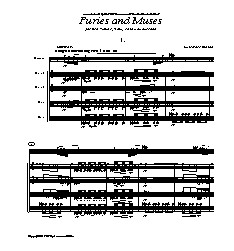for bassoon and string quartet
| SONATA: Allegro moderato e agitato 7:55 |
| ARIA: Andante flessibile 7:40 |
| SCHERZO: Presto energico 4:50 |
| RONDO: Lento – Allegro giocoso 8:45 |
 In Classical mythology, the furies and muses had clearly distinguished roles: the furies exacted revenge through ingenious torments, the muses were shepherdesses to the arts and sciences. In pre-Classical times, however, this distinction was not so clear. The earliest sources indicate that the furies and muses were both aspects of the same goddess in her creative and destructive phases.
In Classical mythology, the furies and muses had clearly distinguished roles: the furies exacted revenge through ingenious torments, the muses were shepherdesses to the arts and sciences. In pre-Classical times, however, this distinction was not so clear. The earliest sources indicate that the furies and muses were both aspects of the same goddess in her creative and destructive phases.
Furies and Muses is a musical juxtaposition of violence and elegance: throughout the piece, aggressive gestures are suddenly transformed into phrases of great delicacy, and vice versa. In many cases, the affect of the music is only thing that is changed, i.e., the gestures retain all of their structural characteristics, but with completely different expressive results.
The four movements — sonata, aria, scherzo, rondo — all use traditional forms in nontraditional ways. The sonata-form first movement, rather than resolving the differences between its themes, drives them further apart from one another. The second movement is an aria about the desire (rather than the ability) to sing. And while the scherzo that follows fits comfortably within the Classical ABA mold, the music is cartoonish in character, with a mock-heroic duet for cello and bassoon in the middle section.
In the final movement, a distant chorale in the strings is answered by a drunken parody of contemporary pop music. A narcissistic fugue exposition follows: each instrument insists on playing nothing but the subject. After the development and intermingling of these three themes, the piece concludes with a furious bacchanal.
Throughout the quintet, the number three plays a prominent role, particularly through the use of meters, 3/4, 3/8, 3/2, 9/8, etc. This numerological consistency is another reflection of the mythological source: the original furies and muses were always described as trinities, only later becoming trinities within trinities, numbering nine each.
A word about the instrumentation: traditionally, the bassoon has been relegated to the role of orchestral clown, mostly because of its ability to articulate rapid passages with startling clarity. As a result, many listeners are unaware of the supple beauty of its tone, which allows it to blend splendidly with almost any other instrument, while still serving as a very effective solo voice. When the bassoon is grouped with a string quartet, the resulting sonority is quite attractive — very rich and dark.
Furies and Muses was commissioned by the 1997 Swannanoa Chamber Music Festival, and premiered there by Jeff Keesecker and the Cassatt String Quartet.
ORDER FURIES AND MUSES:
- score and parts: American Composers Editions
- recording with Jeff Keesecker and the Cassatt String Quartet: www.albanyrecords.com
“[a] fascinating and imaginative score.”
– William Thomas Walker,
CVNC